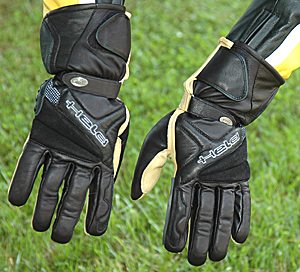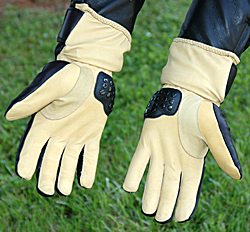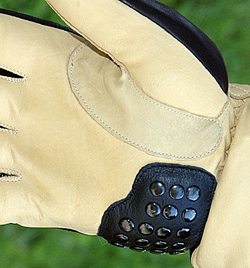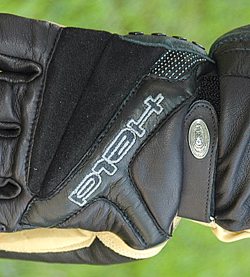Before the days of communication at the speed of light, news about motorcycle gear would travel around the world on the heads, backs and hands of owners returning from Europe.
SCHUBERTH helmets, Hein Gericke leathers and Belstaff clothing are now ubiquitous brands that were once rarely seen outside what was then colloquially termed the “Common Market”.
The Held brand is also included in that list, and Held gloves used to be (and maybe still are) one of the best-kept secrets in motorcycling.
Travelers to Germany would bring back pairs of Held gloves, and a legend was born. People seem to want what they can’t get, and the rarity of Held gloves added to their desirability.
But snob appeal only goes so far to drive demand, and it was the reputation for quality that sustained Held’s growth.
German and European motorcyclists are serious about their craft — they demand the best and Held delivered.
The Held Glove Company has a history about as long as any in motorcycling.
Founded in Germany by Bruno Held in 1923 (the year the first BMW, the R32, was released), the company initially manufactured gloves for mountaineering and it wasn’t until 60 or so years later that the business was expanded to include gloves for motorcycling.
The company is still run by the Held family, and although the stitching and some of the manufacturing is sourced worldwide, the design, raw material sourcing and final inspection is still done in the Held factory in Burberg, Germany.
You can buy extraordinarily cheap gloves just about anywhere in the world today, and if cheap is what you want, cheap is what you’ll get.
Protection seems to have a correlation with cost, and the most inexpensive gloves offer little of it, so what’s the sense?
But Held’s claim to fame is quality, and they’d be foolish to compromise 80-odd years of brand equity by throwing the Held name on a thin pair of Water Buffalo mitts made who-knows-where. But quality doesn’t come cheap, and neither do Held gloves. You want the good stuff, you’ll pay for it.
Held “Steve” Gloves
Some Held gloves can retail for over $200.00, which puts the brand out of reach of a large segment of the motorcycling population. To address this issue, Held recently developed the “Steve” model as a relatively inexpensive, all-around sport and sport-touring glove.
WWhere did the name “Steve” come from? Held developed this model with the help of 125cc Grand Prix wunderkind Steve Jenkner, and the gloves have several features that are common to motorcycle racing gloves but not often found in sport or sport-touring gloves.
Held gloves have a look and feel that immediately marks them as different than your average mitt. The quality of the materials and stitching on Held gloves is first-rate, and it’s no exception with the Steve model.
The leather on the back of the Steve is the new Pittards WR-100X high-performance extreme use leather. This leather is used in outdoor and military gear, and Pittards claims that it has a “high level of durability and resilience”.
WR-100X refers to the special Pittards tanning process, which also helps make the leather resistant to water and sweat, ideal for motorcycle gloves. This is not your average cow hide, and it doesn’t come cheap, thus the higher price.
Steve Gloves Details
The light tan colored palms of the Steve gloves are made from Kangaroo leather. This may be surprising, but Kangaroo leather is claimed to be “one of the strongest lightweight leathers available” (Australian Kangaroo Industry)).
The Australian Kangaroo Industry website has an interesting brief on Kangaroo leather, based on a study conducted to compare abrasion and tear resistance in different types of leather.
(Editor’s Note: See also the Packer Leather website; Packers supplies most of the Kangaroo hide for motorcycle gloves).
The study concluded that when Kangaroo leather is split, it “retains considerably more of the original tensile strength of the un-split leather than does calf.
When split to 20% of original thickness kangaroo retains between 30 to 60% of the tensile strength of the unsplit hide. Calf on the other hand split to 20% of original thickness retains only 1-4% of original strength (Stephens 1987).”
All this is good news for motorcyclists, because the primary function of motorcycle gloves is to protect the hands in a fall and slide, and if Kangaroo leather does a better job than cow hide, so be it.
Kangaroo leather is frequently used in high-end motorcycle racing gloves, and it’s nice to see it in the relatively inexpensive (for Held) Steve model also.
And Held doesn’t just use a tiny patch of Kangaroo hide just for bragging rights. The entire palm, from the fingers all the way up to the end of the gauntlet are made from the stuff.
Kangaroo leather is also supposed to have excellent breathability and sweat resistance, adding to its desirability for use in motorcycle gloves.
It’s interesting to note that Kangaroo leather has a unique feel. It seems to me to be a bit stretchy and it feels something like a cross between silicone, Chamois and leather.
Its strength means that only a thin layer is needed to equal the protection offered by much thicker cow hide, and this is a key benefit. Thinness provides a better feel of the motorcycle’s grips, which translates into improved control of the bike, especially when racing.
Whenever the sensitivity of feeling can be improved, the rider will have quicker access to knowledge about what the bike is doing.
That’s one of the reasons that motorcycle racing boots, racing gloves and even seats are thin and hard. It helps transmit the information exuded by the bike in the form of “feel” (“the bike speaks to me”) that gives the racer that millisecond advantage.
The gauntlets are nice and long, and the palm side includes some elastic in the cuff that helps them stretch over the sleeve of a motorcycle jacket. The cuffs are also adjustable via a “hook and loop” material on the inside of the wrist.
The outside of the wrist includes a small patch of “Suprotect” padding covered with Carbon-Aramid-Kevlar fabric to help protect that area.
 Other Features
Other Features
The Steve gloves have several other features that were pioneered in the world of motorcycle racing.
The palms have an extra patch of leather holding 22 riveted slider buttons, again backed by Suprotect foam padding and DuPont’s Nomex and Schoeller Kevlar lining.
The sliders are designed to allow the rider’s hands to slide along the ground during a fall, which can help prevent the glove from catching and twisting a finger or arm.
Held uses a special process to flatten and countersink the rivets to help withstand the forces applied during a slide.
Nomex backing is used to help prevent burns created by friction during a slide, and Kevlar is also used, which provides a further layer of impact protection.
The gloves also use Schoeller Keprotec fiber for the stitching; Keprotec is a derivative of Kevlar and much stronger than cotton or other fibers.
The palms of the Steve gloves have an extra patch of Kangaroo leather between the thumb and forefinger, which provides some extra resistance to the wear.
The backs of the gloves have sections of relatively heavy padding under the black leather, and the padding covers most of the top of the hand, including the fingers.
An extra section of leather protects the knuckles — Held doesn’t use carbon fiber or hard armor on this glove, which will be appreciated by those who don’t like the look or feel of gloves with knuckle armor.
The absence of hard armor also means that the gloves can be folded up and pack into a relatively small space.
The use of leather and padding, rather than hard armor, also helps to provide more flexibility in the Steve glove, with a potentially higher level of comfort, especially for long-distance touring.
Held uses a “hook and loop” cinch adjuster on the back of the wrist to secure the glove to the rider’s hand.
The cinch can be snugged up nice and tight to keep the glove in place; after all, even the best glove won’t protect the rider’s hands if it falls off in a crash.
We’ve seen many other gloves that have a cinch strap that doesn’t really do its job. If you can cinch up a glove and then pull it off your hand, it’s either too loose or improperly designed.
Held uses a special stitching method for the fingers of the Steve glove. The fingers have a box-type cross section, which provides much more room than other configurations.
This is good news for those with thick fingers; if you have large diameter digits and you’ve had problems finding gloves that fit or that feel comfortable, the Steve model may solve your problem.
On the flip side, riders with thinner fingers may find that the box section has too much room and the gloves may feel loose. Held offers a wide variety of sizes to ensure the correct fit, including half sizes, so make sure you measure your hands using Held’s guidelines before you buy a pair.
The box section can be envisioned by imagining that a finger on the glove was cut perpendicular to its length. The box section basically looks like a floor (the palm), a roof (the back of the glove), and two leather walls (the material on each side of the finger).
TThis method of stitching is more labor intensive (Held claims 30 minutes for this step) because of the four seams, but it provides much more finger room.
Held also uses a special stitching process to attach the palm side of the fingers (the “floor”) to the sides of the fingers (the “walls”). Held calls this a “step” seam, meaning that the leather sections are overlapped and then stitched flat.
Held claims that this prevents bulging seams and provides a more sensitive feel for the controls.
And last but not least, Held also added a rubber wiper on the left-hand index finger, which can be used to wipe off the motorcycle helmet visor during a ride.
Conclusion
Held designs and manufactures some of the highest quality motorcycle gloves available. While other brands may advertise comparable features, there’s definitely a comfort factor in knowing that Held gloves use some of the best quality materials available, and the designs are a result of real-world engineering.
The Steve model is somewhat unique, because it brings motorcycle racing technology to an all-around street glove. The Steve gloves are comfortable and they give the rider a high level of sensitivity for the motorcycle’s controls.
The design of the fingers should satisfy riders with thicker hands who haven’t been able to find gloves that fit correctly.
The Steve gloves are slightly on the expensive side, but the level of quality, the materials and the design are worth it and they should provide the owner with many miles of comfort and protection.




 Other Features
Other Features